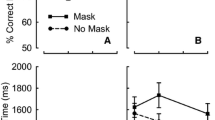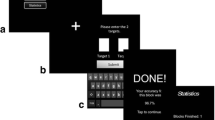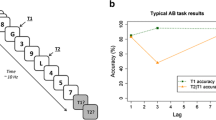Abstract
The identification of the second of two targets presented in close succession is often impaired—a phenomenon referred to as the attentional blink. Extending earlier work (Di Lollo, Kawahara, Ghorashi, and Enns, in Psychological Research 69:191–200, 2005), the present study shows that increasing the number of targets in the stream can lead to remarkable improvements as long as there are no intervening distractors. In addition, items may even recover from an already induced blink whenever they are preceded by another target. It is shown that limited memory resources contribute to overall performance, but independent of the attentional blink. The findings argue against a limited-capacity account of the blink and suggest a strong role for attentional control processes that may be overzealously applied.






Similar content being viewed by others
References
Akyürek, E. G., & Hommel, B. (2005). Short-term memory and the attentional blink: Capacity versus content. Memory & Cognition, 33, 654–663.
Ashby, F. G., Isen, A. M., & Turken, A. U. (1999). A neuropsychological theory of positive affect and its influence on cognition. Psychological Review, 106, 529–550.
Brehaut, J. C., Enns, J. T., & diLollo, V. (1999). Visual masking plays two roles in the attentional blink. Perception & Psychophysics, 61(7), 1436–1448.
Chun, M. M., & Potter, M. C. (1995). A two-stage model for multiple detection in RSVP. Journal of Experimental Psychology: Human Perception and Performance, 21, 109–127.
Cowan, N. (2000). The magical number 4 in short-term memory: A reconsideration of mental storage capacity. Behavioral and Brain Sciences, 24, 87–185.
Dell’Acqua, R., Pascali, A., Jolicoeur, P., Sessa, P. (2003). Four-dot masking produces the attentional blink. Vision Research, 43, 1907–1913.
Derryberry, D., & Tucker, D. M. (1994). Motivating the focus of attention. In P. Niedenthal, & S. Kitayama (Eds.), The heart’s eye: EMotional influences in perception and attention (pp. 167–196). San Diego: Academic.
Di Lollo, V., Kawahara, J., Ghorashi, S. M. S., & Enns, J. T. (2005). The attentional blink: Resource limitation or temporary loss of control? Psychological Research, 69, 191–200.
Giesbrecht, B., & DiLollo, V. (1998). Beyond the attentional blink: Visual masking by object substitution. Journal of Experimental Psychology: Human Perception and Performance, 24(5), 1454–1466.
Grandison, T. D., Ghirardelli, T. G., & Egeth, H. E. (1997). Beyond similarity: Masking of the target is sufficient to cause the attentional blink. Perception & Psychophysics, 59(2), 266–274.
Jolicoeur, P., & Dell’Acqua, R. (1998). The demonstration of short-term consolidation. Cognitive Psychology, 32, 138–202.
Kahneman, D., Beatty, J., & Pollack, I. (1967). Perceptual deficit during a mental task. Science, 157, 218–219.
Kawahara, J.-I., Zuvic, S. M., Enns, J. T., & Di Lollo, V. (2003). Task switching mediates the attentional blink even without backward masking. Perception & Psychophysics, 65(3), 339–351.
Kawahara, J., Enns, J. T., & Di Lollo, V. (2005). The attentional blink is not a unitary phenomenon. Psychological Research (in press).
Kessler, K., Schmitz, F., Gross, J., Hommel, B., Shapiro, K., & Schnitzler, A. (2005). Target consolidation under high temporal processing demands as revealed by MEG. NeuroImage, 26(4), 1030–1041.
Maki, W. S., Frigen, K., & Paulson, K. (1997). Associative priming by targets and distractors during rapid serial visual presentation: Does word meaning survive the attentional blink? Journal of Experimental Psychology: Human Perception and Performance, 23(4), 1014–1034.
Maki, W. S., Bussard, G., Lopez, K., & Digby, B. (2003). Sources of interference in the attentional blink: Target-distractor similarity revisited. Perception & Psychophysics, 65, 188–201.
Martens, S., Wolters, G., & Van Raamsdonk, M. (2002). Blinks of the mind: Memory effects of attentional processes. Journal of Experimental Psychology: Human Perception and Performance, 28(6), 1275–1287.
Nieuwenhuis, S., Gilzenrat, M. S., Holmes, B. D., & Cohen, J. D. (2005). The role of the locus coeruleus in mediating the attentional blink: A neurocomputational theory. Journal of Experimental Psychology: General, 134, 291–307.
Nieuwenstein, M. R., Chun, M. M., Lubbe, R. H. J. v. d., & Hooge, I. T. C. (2005). Delayed attentional engagement in the attentional blink. Journal of Experimental Psychology: Human Perception and Performance (in press).
Olivers, C. N. L., & Nieuwenhuis, S. (2005a). The beneficial effect of concurrent task-irrelevant mental activity on temporal attention. Psychological Science, 16(4), 265–269.
Olivers, C. N. L., & Nieuwenhuis, S. (2005b). The beneficial effects of additional task load, visual distraction, and positive affect on the attentional blink. Journal of Experimental Psychology: Human Perception and Performance (in press).
Potter, M. C., Chun, M. M., Banks, B. S., & Muckenhoupt, M. (1998). Two attentional deficits in serial target search: The visual attentional blink and an amodal task-switch deficit. Journal of Experimental Psychology-Learning Memory and Cognition, 24(4), 979–992.
Potter, M. C., Staub, A., & O’Conner, D. H. (2002). The time course of competition for attention: Attention is initially labile. Journal of Experimental Psychology: Human Perception and Performance, 28(5), 1149–1162.
Potter, M. C., Dell’Acqua, R., Pesciarelli, F., Job, R., & Peressotti, F. (2005). Bidirectional semantic priming in the attentional blink. Psychonomic Bulletin & Review, 12(3), 460–465.
Raymond, J. E., Shapiro, K. L., & Arnell, K. M. (1992). Temporary suppression of visual processing in an RSVP task: An attentional blink? Journal of Experimental Psychology: Human Perception and Performance, 18, 849–860.
Raymond, J. E., Shapiro, K. L., & Arnell, K. M. (1995). Similarity determines the attentional blink. Journal of Experimental Psychology: Human Perception and Performance, 21, 653–662.
Seiffert, A. E., & DiLollo, V. (1997). Low-level masking in the attentional blink. Journal of Experimental Psychology: Human Perception and Performance, 23(4), 1061–1073.
Shapiro, K. L., & Raymond, J. E. (1994). Temporal allocation of visual attention. In D. Dagenbach & T. H. Carr (Eds.), Inhibitory Processes in Attention, Memory, and Language (pp. 151–188). San diego: Academic.
Shapiro, K. L., Raymond, J. E., & Arnell, K. M. (1994). Attention to visual pattern information produces the attentional blink in RSVP. Journal of Experimental Psychology: Human Perception and Performance, 20, 357–371.
Shapiro, K. L., Arnell, K. M., & Raymond, J. E. (1997). The attentional blink. Trends in Cognitive Sciences, 1, 291–296.
Theeuwes, J. (1992). Perceptual selectivity for color and form. Perception & Psychophysics, 51, 599–606.
Visser, T. A. W., Bischof, W. F., & DiLollo, V. (1999a). Attentional switching in spatial and nonspatial domains: Evidence from the attentional blink. Psychological Bulletin, 125(4), 458–469.
Visser, T. A. W., Zuvic, S. M., Bischof, W. F., & Di Lollo, V. (1999b). The attentional blink with targets in different spatial locations. Psychonomic Bulletin & Review, 6(3), 432–436.
Visser, T. A. W., Bischof, W. F., & Di Lollo, V. (2004). Rapid serial visual distraction: Task-irrelevant items can produce an attentional blink. Perception & Psychophysics, 66(8), 1418–1432.
Yantis, S., & Jonides, J. (1984). Abrupt visual onsets and selective attention: Evidence from visual search. Journal of Experimental Psychology: Human Perception and Performance, 10, 601–621.
Author information
Authors and Affiliations
Corresponding author
Rights and permissions
About this article
Cite this article
Olivers, C.N.L., van der Stigchel, S. & Hulleman, J. Spreading the sparing: against a limited-capacity account of the attentional blink. Psychological Research 71, 126–139 (2007). https://doi.org/10.1007/s00426-005-0029-z
Received:
Accepted:
Published:
Issue Date:
DOI: https://doi.org/10.1007/s00426-005-0029-z




